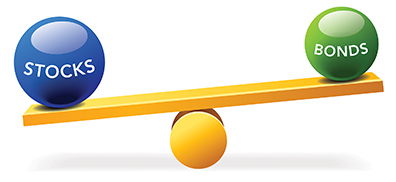Your Asset Allocation Depends On Your Financial Plan (and not the other way around)
~ Douglas R. Mewhirter, CFA, Senior Vice President – Portfolio Manager
One of the most common questions an investor will ask an advisor is “how much of my money should I have in stocks vs. bonds?”
From an investing point of view, that is one of the most important questions you need to ask.
Stocks have earned the highest long-term returns of any major asset class, as stockholders participate in the growth of the company’s profits and dividends. However, high returns come with high volatility, because small changes in the growth outlook of a stock can drive very large changes (higher or lower) in the value of a stock in a short period of time. In contrast, bond interest and principal payments don’t grow, but are contractually guaranteed by the company or government. This makes investment-grade bonds generally more predictable and stable than stocks and subject to much less volatility. However, the investor “pays” for that stability with generally lower returns.
 By combining stocks and bonds in your portfolio, you can choose how much return you shoot for and how much you are willing to risk in terms of volatility by adjusting the ratio of stocks vs. bonds. Bonds provide a nice cushion (and some income) that can be used to stabilize the much wilder swings of stocks, but too much of your portfolio in bonds can result in low long-term returns.By combining stocks and bonds in your portfolio, you can choose how much return you shoot for and how much you are willing to risk in terms of volatility by adjusting the ratio of stocks vs. bonds. Bonds provide a nice cushion (and some income) that can be used to stabilize the much wilder swings of stocks, but too much of your portfolio in bonds can result in low long-term returns.
By combining stocks and bonds in your portfolio, you can choose how much return you shoot for and how much you are willing to risk in terms of volatility by adjusting the ratio of stocks vs. bonds. Bonds provide a nice cushion (and some income) that can be used to stabilize the much wilder swings of stocks, but too much of your portfolio in bonds can result in low long-term returns.By combining stocks and bonds in your portfolio, you can choose how much return you shoot for and how much you are willing to risk in terms of volatility by adjusting the ratio of stocks vs. bonds. Bonds provide a nice cushion (and some income) that can be used to stabilize the much wilder swings of stocks, but too much of your portfolio in bonds can result in low long-term returns.
Many do-it-yourself investors either put everything in stocks and plug in “8%-12% returns” – and stay up all night in a cold sweat when stocks drop 20%-30% (which is pretty much guaranteed to happen in any given ten-year period), while others pick a rule of thumb, like the “60/40 portfolio” or “110% minus your age in stocks.”
However, we would argue that trying to figure out the asset allocation first is putting the cart before the horse, because investing is a means to an end, and not the goal itself. The goal – for most people – is a comfortable retirement and maybe a little left over for the kids. Once you figure out what that looks like, then you work backward to see a) how much that would cost in terms of annual spending and b) how much of a nest egg is needed to fund that spending. Once that is determined, then you can start thinking about asset allocation.
Everyone’s situation is different. One family with $5 million socked away might actually have a lower risk tolerance than someone with $1 million. The $5 million family may have a high ongoing spending requirement (e.g., a chronic health condition, a special needs child, etc.) and also have a “chunky” spending pattern early in retirement (e.g. paying for three weddings over the course of five years, plus helping kids out with student loans).
The $1 million couple may only have one child that is out of the house with a high-paying job, plus a generous pension and low ongoing spending needs. Accordingly, a 30% drop in the $5 million portfolio may hurt that family more than the family with the $1 million portfolio, because their financial goals are different.
So, it all hinges on your plan. Do you have a financial plan? We may be able to help you if you don’t (or if your current one is outdated). It doesn’t have to be overly complicated and definitely shouldn’t be carved in stone. But, a sound financial plan that is tied to your future goals can help clarify the age-old question of “how much should I invest in stocks?”